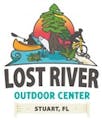Campers will embark on an unforgettable summer adventure at Lost River Outdoor Center Summer Adventure Camp!
- 5 days









Environmental Explorations
Each program begins with a live animal presentation based on an environmental theme followed by an interactive activity, and ending with an artwork that children can take home. Participants have the opportunity to touch live animals at the end of each presentation.
- “Ocean to Lake” – This program focuses on the unique animals that live in the fresh water of Lake Okeechobee, leading to the historic St. Lucie River, winding through to the salty ocean. Children touch a live snake to see if it feels slimy and then find out how alligators differ from crocodiles. Discover why an “upside down jellyfish” lives upside down, learn about the endangered manatee, and create your own manatee mask.
- “Ocean Commotion”- Come with us on a diving adventure to the coral reef, one of the most important places on planet Earth! Explore three ocean habitats and learn about the animals who live there. Following a close-up look at live animals like a fighting conch and hermit crab, children sort ocean animals and place them in their home in this interactive giant floor map activity. Complete the adventure by creating a shell craft.
- “Fishy Myths and Facts”- Is a shark a fish? How about a seahorse or eel? Learn about the different types of “fishy fish” that live in our waters. See a live pufferfish in action and discover how it defends itself. Learn about unique adaptations like camouflage and countershading, and paint a “Gyotaku” fish print.
- “Earth Caretakers” – Children learn how they can protect our environment in this interactive program. We begin by comparing the live aquatic turtle with the sea turtle model and see how balloons are mistaken for its food. Take part in a recycling race and construct upcycled art from objects we dispose of every day.
- “Endangered or Extinct?”- Children become paleontologists as they identify a mystery dinosaur skull to begin this endangered species program. Live native and exotic animal differences are discussed. Following an archaeological dig for artifacts, children take home fossil rubbings they create.
Archery Basics
This program is designed to teach the participant the basic safety issues and commands, equipment, and proper safe shooting technique that will enable them to shoot with confidence and to enhance their shooting as they progress in the sport of archery. The instructor has been trained and certified by USA archery and will coach the archers.
The program is designed for adults and children ages 8 and above. Children under 8 would need to use different equipment so they are comfortable.
Archery can run for 1 to 1.5 hours which allows for a good amount of practice time for the individual. The first 20 minutes or so is spent taking them through the safety issues and commands and then teaching them the proper shooting technique.
Archers will use Genesis compound bows that come sized for both adult and child and have both right and left handed bows. The targets are placed approximately 25 feet away from the archers although they could be moved closer for younger participants. The arrows are Easton target arrows that are designed for the genesis bow. There are different targets that are available and a heavy gauge safety net can be hung as a backstop for the arrows. Signs are placed around the sight to let others know that there is an active archery range practice going on.
This sport is growing quickly in popularity and clubs are sprouting up that archers can join if interested.


John Welch
John Welch has twenty-eight years of experience as a Naturalist, including 17 years with the Palm Beach County Parks and Recreation Department. He has been a Volunteer Coordinator/Naturalist and Marine Science Technician at Riverbend Park, and Okeeheelee Nature Center. Prior to this, he was the Manager of an Outreach Company, “Florida Flora and Fauna, Inc.,” presenting science and environmental outreach programs throughout Palm Beach county for 10 years. He has also worked as an Historical Interpreter for the Jamestown-Yorktown Foundation in Virginia for 4 years and was an interpreter at The Flagler Historical Museum in Miami for two years.
John has certifications as an ACA Paddle instructor for both canoe and kayak and also as a USA archery instructor. He also holds certifications in First Aid and Crowd management. He has a B.A. in Speech Communications from Lynchburg College.

